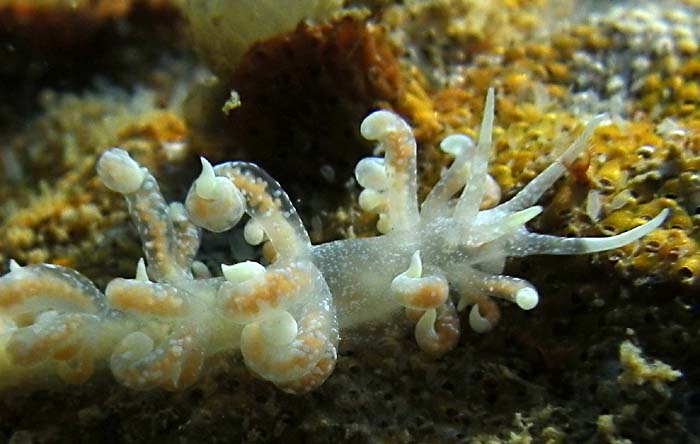This species has been observed on Reunion and Mayotte Islands
Body translucent pink with numerous opaque white spots on the surface of the notum, cerata, rhinophores and oral tentacles Cerata curved, with a cream apical region. The lateral branches (secondary branches) of the digestive glande are visible through the cerata wall. The oral tentacles and the smooth rhinophores are long and tapering with a creamish white distal half |
 |
|
| Showing species characteristics... | Photo Philibert Bidgrain |
|
See more about : Sightening and mating periods
See more about : Phyllodesmium cf poindimiei a variability in Southwest Indian ocean
See more about : Phyllodesmium phylogeny by Moore & Gosliner, 2009
See more about : Phyllodesmium ceratal arrangement by Rudman, 1991
See more about : Ceratal structure in Phyllodesmium by Rudman, 1991
Remarks :
Identification confirmed by Nathalie Yonow and Hsini Lin
Our specimens looks like P. poindimiei but they present some colour difference from the typical pattern of this species, so we call it P. cf poindimiei.
- Absence of bluish (blue iridescence) to purple markings on the cerata, oral tentacle and rhinophores
- The branches of the digestive gland aren't pinkish red to orange, and the distal sections aren't yellowish
| Bibliographic data (P. poindimieri) :
|
 |
It feeds on the alcyonarian corals belonging to the family Clavulariidae Telesto sp and Carijoa sp in New South Wales and Carijoa sp in tropical waters.
It's primarily nocturnal, concealing itself near the bases of the octocoral during the day and crawling out to the tips of the plumes at night
Wagner & al. (2009) reported that it lays a white spiral egg mass that hatches in 5-6 days in the laboratory and that it is preyed on by the swimming crab Thalamita integra.
References :
Bill Rudman Seaslug site : Sea Slug Forum : Phyllodesmium poindimiei
Nudipixel Phyllodesmium poindimiei
Publications :
Risbec, J., 1928. Contribution à l'étude des nudibranches Néo-Calédoniens. Faune des Colonies Françaises, 2 : 1-328.
Rudman, W.B. (1981) The anatomy and biology of alcyonarian feeding aeolid opisthobranch molluscs and their development of symbiosis with zooxanthellae. Zoological Journal of the Linnean Society, 72 : 219-262
Rudman, W.B. (1991) Further studies on the taxonomy and biology of the octocoral-feeding genus Phyllodesmium Ehrenberg, 1831 (Nudibranchia: Aeolidoidea). Journal of Molluscan Studies, 57(2) : 167-203.
Wagner, D., S. E. Kahng & R. J. Toonen. 2009. Observations on the Life History and Feeding Ecology of a Specialized Nudibranch Predator ( Phyllodesmium poindimiei ), with Implications for Bbiocontrol of an Invasive Octocoral ( Carijoa riisei ) in Hawaii, J. Exp. Mar. Biol. Ecol. (2009)
Other photos of Phyllodesmium cf poindimiei :
Photo Philibert Bidgrain Reunion, La Saline lagoon, less 1 m, 26 January 2010, size : 20-22 mm
|
- The tail is long and the tip is pointed (a) |
 |
|
 |
Photo Christophe Cadet
Reunion, La Saline lagoon, less 1 m , 30 December 2009, size : 13 mm Two specimens with its spawn
Wagner & al. (2009) reported that it lays a white spiral egg mass
|
Photo Norbert Verneau Mayotte, platier rocheux de Pamandzi, less 1 m, 17 October 2010, size : 15 mm In this specimen we can see two others characteristic of P. poindimiei : - The branches of the digestive gland are orange (a) - Presence of bluish (blue iridescence (b))to purple markings on the cerata, oral tentacle and rhinophores |
 |
 |
Photo Eva Fontaine Mayotte, "Gombé Ndroumé", less 1 m, 21 December 2011, size : 10-15 mm - The branches of the digestive gland are orange but absence d'iridescence bleue...
|
More photos from Indian Ocean
See more about : Phyllodesmium cf poindimiei a variability in Southwest Indian ocean
See more about : Phyllodesmium phylogeny by Moore & Gosliner, 2009
See more about : Phyllodesmium ceratal arrangement by Rudman, 1991
See more about : Ceratal structure in Phyllodesmium by Rudman, 1991